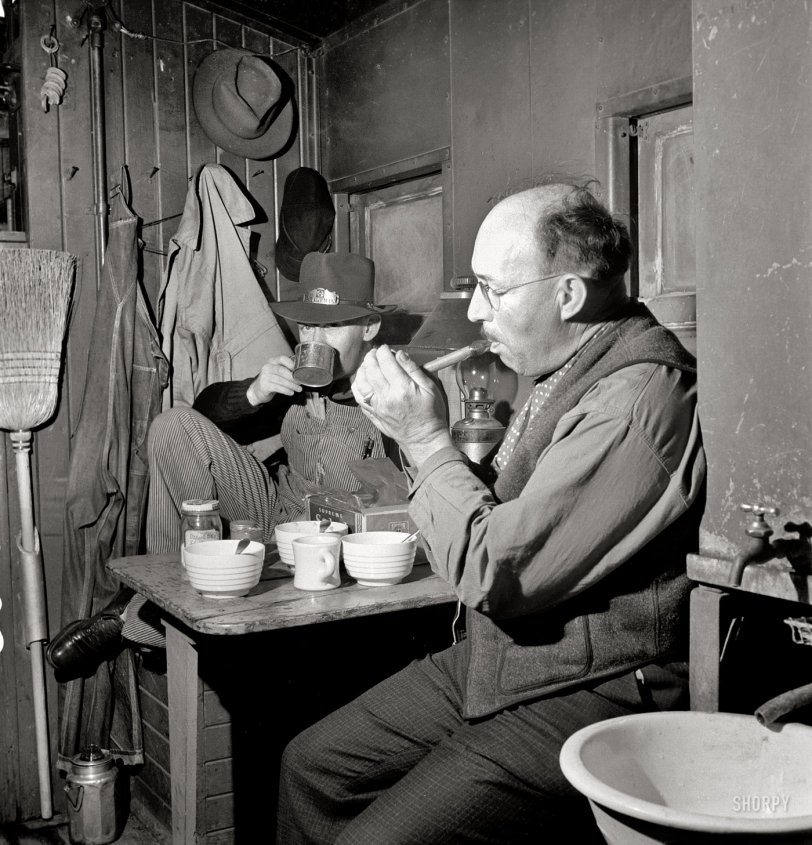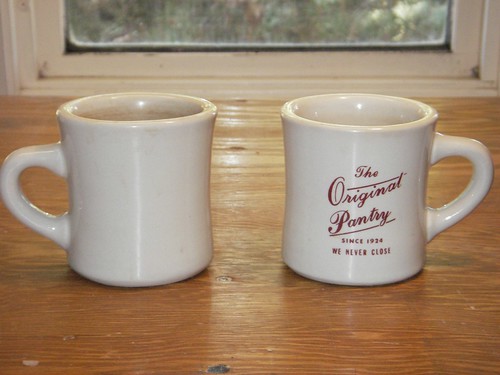


Framed or unframed, desk size to sofa size, printed by us in Arizona and Alabama since 2007. Explore now.
Shorpy is funded by you. Patreon contributors get an ad-free experience.
Learn more.

- Baldwin 62303
- Baldwin VO-1000
- Cold
- No expense spared
- Tough Guys
- Lost in Toyland
- And without gloves
- If I were a blindfolded time traveler
- Smoke Consumer Also Cooks
- Oh that stove!
- Possibly still there?
- What?!?
- $100 Reward
- Freeze Frame
- Texas Flyer wanted
- Just a Year Too Soon
- WWII -- Replacing men with women at the railroad crossing.
- Yes, Icing
- You kids drive me nuts!
- NOT An Easy Job
- I wonder
- Just add window boxes
- Icing Platform?
- Indiana Harbor Belt abides
- Freezing haze
- Corrections (for those who care)
- C&NW at Nelson
- Fallen Flags
- A dangerous job made worse
- Water Stop
Print Emporium
Jim and Jack: 1943

March 1943. "Conductor James M. Johnson and brakeman Jack Torbet having lunch in the caboose on the Atchison, Topeka and Santa Fe Railroad between Waynoka, Oklahoma, and Canadian, Texas." Medium-format nitrate negative by Jack Delano for the Office of War Information. View full size.
Jack's Timebook
Jack Torbet's railroad timebook is on exhibit at the Panhandle-Plains Historical Museum in Canyon, Texas. If I recall correctly, it's open to a page from WWII. Timebooks are where railroaders keep a record of their trips for pay and tax purposes. Apparently Mr. Torbert donated several items to the museum at some point.
Jeff Ford
Amarillo
Sweet vest
The guy on the right looks to be wearing a Brown's Beach Coat vest. Very nice piece of Americana workwear. The guy on the left is just pure style from his fedora to his railman boots. Love this photo.
Mugs still available
Great photo, and my eye went to the mugs as well. These are still available. I found my first one at the Original Cafe in L.A. in 1992. Cost two bucks, and is (or was?) a place that Jim and Jack would recognize. I have another which I bought maybe 5 years ago, at a restaurant supply store, for not much more. The difference was that this one had the handle in the "wrong" place.

Thanks again for this great photo -- made my lunchtime today. The coffee pot on the floor would look great in my kitchen, too.
Nice Mug, Buddy redux
I agree with Jano on the mug. As a potter, I looked at the bowls and mug first. The bowls look like Japanese tea bowls, with a nice foot ring. The mug reminds me of the days on the road as a musician drinking cup after cup of coffee from just such a mug. Thick and heavy, they could keep a cup of coffee warm for hours.
They are the bright spot in the photo, in the center. Whose hat is hanging on the wall? This is a great photo with superb detail.
Worker's Paradise - NOT!
The caboose was hardly a "luxury for the workers." First up, it’s not the safest place on earth. Especially during steam days, the slack action (the front of the train starts before the back; the force of acceleration is transmitted and increases between cars) could be so severe that crewmen were thrown from their seats and injured — have also heard of cabooses being jolted so hard the stove broke loose from the floor. Rear end collisions were also a fact of life, adding to the danger. In helper districts, it was possible to shove too hard and buckle the underframe.
Cabooses in this period were assigned to a conductor; they didn't go "cross-country," but roughly 100+ miles between division points. The car served as office and lookout to increase safety, its function as bedroom and kitchen was secondary – engine crews stayed in nearby boarding houses or railroad hotels — train crews slept in the car, spotted on a designated caboose track in the yard or near engine service areas. Basically you never left your job, and yards were never quiet day or night.
They added weight to trains, generated no revenue, added switching and maintenance costs and were basically wearing out by the 1980s. Technology and progress made it possible to eliminate them, much as diesels replaced steam.
AT&SF trainman
My grandfather, an AT&SF engineer during the same period these men helped get freight over the road, had his "Engineer" badge on a ten-gallon Stetson. After he exclusively ran diesels (this was in 1953, he was a passenger engineer), he switched over to a white hat just to make the Union Pacific and Southern Pacific engine crews envious of working conditions on the Santa Fe. I still have the hat and badge.
Cabooses
A good friend retired from the railroad and was working when the caboose was still used. The railroad had the caboose as someplace for the workers to stay when they were not on shift. For long cross-country trips, the caboose was used for sleeping and recreation. The railroads determined that this was a luxury for the workers and then eliminated the caboose.
Warm Topper
Just found another one of my grandfather's Kromers in a box of hats last night. It's just like the one hanging on a nail behind the brakeman.
Nice mug, buddy
My grandmother had those huge white stoneware mugs that could keep coffee hot for hours. The glaze was crazed from decades of us. When her farmhouse was emptied, I always regretted not snagging one of those. They likely were thrown out. I can't say much about the tin cup the other guy is using. The heat conductivity would burn your fingers and lips, and you'd have to drink fast if you wanted anything hot. The only time a metal cup was a good idea was dipping it into the milkhouse cooling trough for a cold drink.
By the way, I've never seen anyone look more dapper in overalls, of all things, than this fellow. It's as if he should break out in song after tapping out a rhythm on the table with his cup.
That's a bad brim.
The brakeman is sporting one very cool lid and I think he knows it. Jack Delano does it once again.
























On Shorpy:
Today’s Top 5